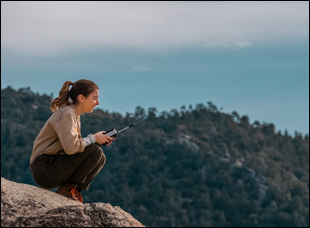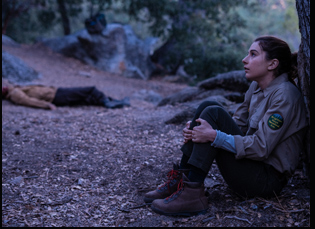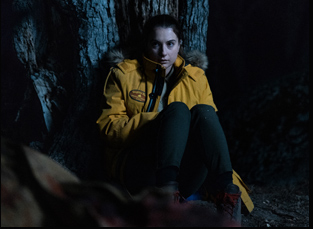Every so often when Roxanne Benjamin would take a nature walk with her dad, the two would occasionally stroll past something sketchy in the woods.
“You’re actually in a pretty dangerous situation without realizing it and I think we walk into those situations quite a lot in our daily life without realizing it,” says Benjamin. “And this is the movie about realizing it.”
Although subsequent stint in the forestry service and a skill for scaring the bejeezus out of people with entries into the horror anthologies “VHS,” “Southbound” and “XX” prepared Benjamin well for “Body at Brighton Rock,” you can’t say the same for Wendy (Karina Fontes), the carefree park ranger making a little cash with her friends with the summer job, blissfully unaware that her playlist that includes Oingo Boingo’s “Dead Man’s Party” and Expose’s “Point of No Return” are going to take on a new context while she’s posting safety notices about snakebites and frostbite to trees. There is no such warning, however, for what to do if you discover a rotting corpse that suspiciously appears as if it’s the result of a murder, and after taking a selfie in a section of the forest her friends tell her isn’t where she thinks it is, Wendy worries she’s in over her head when she comes across the deceased, with Benjamin brilliantly showing that the fear of doing the right thing in an extraordinary situation can be as anxiety-inducing as self-preservation.
After creating the opportunities for herself to direct by producing the anthologies she helmed segments of, there is something particularly rewarding about Benjamin choosing to tell the story of a resourceful young woman surprising herself with her own strength and resilience as Wendy waits for authorities to come claim the body while nefarious characters ranging from creepy people to ferocious bears lurk about. While not skimping on the skillful scares, Benjamin makes them all the more impactful with how endearing “Body at Brighton Rock” is with a winning lead performance from Fontes and a charming self-awareness. Following well-received bows at SXSW and New York’s What the Fest!?, the film is hitting theaters and VOD this week and the writer/director graciously took the time to talk about making a low-budget production feel as big as “Body at Brighton Rock” does, finding such a strong lead actress to carry such a thriller on her shoulders and the books that were more influential than other films to get the film’s unusual tone just right.

No. My [cinematographer] Hannah Getz and I had gone around to a couple different parks within four or five hours of Los Angeles and Idyllwild made the most sense in terms of the production because there were places to house people and it’s pretty mild terrain for the most part. It gave us all the locations we needed in a pretty compact area, but we were still ranging up and down like three-quarters of a mile of a trail from like top to bottom on the side of this mountain in Idyllwild on the daily, so that presents its own challenges, and it’s [already] a pretty challenging movie to make, just because we were out in the elements. The thing you’re not supposed to do on an indie budget is have animals and be outside and have a lot of nighttime stuff and this did all of those things. [laughs]
I imagine you had a pretty specific shotlist since it really immerses you in nature, but when the elements can change on a whim, does that complicate things?
Once we land in that clearing, it becomes a chamber drama. It becomes very much one girl in one place and her action is really inaction. Her action is not to run, which is the hardest thing, so those scenes I felt I had more of an idea of how I’d block them out where a lot of it I wouldn’t say improv because the shots I wanted were very calculated, but you’re at the mercy of what you can get on the mountain. The light changes up there so quickly and we only had 11 days to shoot, and we got stuck in a windstorm for two days that was the worst – they created a new category for it, category purple – and they shut the power down in the town we were in for two days, so we couldn’t shoot. We were making up things to shoot inside the Nature Center because there’s no cover sets when your entire set is nature. So my 11-day shoot, which is already ludicrous turned into a nine-and-a-half day shoot, and there were some very specific things I wanted to get, but then I also had a flexible idea of what some of those other scenes would look like or some of that traveling on the trail would look like versus the specific moments.
I know Karina had a small part in “Southbound.” Did you have her in mind from the start?
I did actually. She had not really acted. She’s been in like a short or two, but for “Southbound,” she’s a friend of Fabienne [Therese], who was one of my three girls, so I needed a dead bandmate and they were like, “Oh, our friend Karina will do it.” [laughs] And she’s actually a model by trade and I didn’t realize she actually wanted to act, but I had her read for another role at a table read for another script that I had, and she was great at it. She has a very specific [quality] that I think is hard for an actor to pull off, that she does somewhat naturally, which is that she’s able to be completely vulnerable and open on camera in a way that’s very interesting to me. That’s not something you can really learn and she’s also able to switch that to a position of strength, so to see someone have both of those talents in one, I definitely had her in mind while I was writing it and it was just convincing the rest of the team that she was the right person because she’s never acted before and she has to carry the movie.
The whole movie pivots on her performance, and much of it is a somewhat silent movie that relies on the emotion of her face to convey so much of what the story is. There’s also an eight-minute monologue in the middle of the movie on the radio, so she had to be able to have both of those skills, but once [the producers saw an audition tape of her doing part of that monologue, it was like, “Oh yeah, she’s great. She’s perfect.”

Poor thing. It was me. I was reading the other lines in there. I’m on another rock, yelling them out to her on her rock, so that I’m sure was probably very tough for her because an actress I am not. [laughs]
And you pretty much have to create a cell service from scratch, so all the text messages on her phone you have to design, right?
Oh yeah, you do. You do. And my financiers Soapbox Films are also a production house, so I have a lot of stuff in this movie that you would not be able to have on a movie of this budget size without them. There’s over 300 VFX shots in the movie and those text shots are some of them. Dave Smith and Chris Allender, my producers – that’s all of their team. They’re great. They did all of the VFX in the movie, the color and then I work with (Owen Greenwich Young) for sound design on all my movies. He’s done all our “VHS” movies,” “Southbound,” and the overall mix for “XX,” and I work with him on everything. I also work with the same composers on everything, The Gifted, and they’re great. The sound and the score are so important to this movie in particular because it’s mostly a silent movie, so they’re like my ride or die. I had a lot of resources. [Soapbox] also had a stage, so we were able to do a couple pickup shots when we needed them.
You’ll notice too…well, maybe not, there are two little Easter eggs in there from my other films, which is the station wagon that she runs by in the beginning – Darrell, our sound guy is the driver in there and it’s his station wagon, the same one that the couple is in “Siren,” my section of “Southbound,” and the license plate says “Southbound.” And yeah, then the cell service on her phone is SHV – “VHS” backwards, because you have to make up a cell service. You can’t just use AT&T – they don’t want to show you can’t use their service somewhere, so there are two little nods to other films that I’ve done. [laughs]
I love that there’s now an entire Roxanne Benjamin universe to draw on.
Yeah, that is actually pretty funny. [laughs] Also, YA novels are obviously a big influence on this movie and I wanted to make something that would very much be like a Christopher Pike story. I was a huge Christopher Pike fan when I was 12 or 13 years old and this is who I see the movie for, so I wanted to get that feel across, where it was a suspense mystery and you didn’t quite know whether it was supernatural or there was like a killer or sometimes it was both. To just make it a ghost story or a survival story was boring to me, but this was a way of playing with both elements and into a style that I remember from my childhood that I was nostalgic for in the same way I feel other people are making movies based on their nostalgia for other movies. Mine is like a nostalgia for books.

No, because I wanted the tone to almost be like “Caddyshack.” We’re subjectively in her experience this entire movie, so [at first] we’re in an ‘80s summer movie [because she’s in] that kind of headspace and then it turns into mystery/thriller and then it turns into horror and then survival and all of those are just what she’s going through. And the score does the same thing – it sits on top of the movie instead of being baked into it because that entire score is her inner monologue, so everything she’s feeling is what the score is doing and it almost comes in a beat before it should on every moment because it’s like her emotional headspace of where it normally would if you scored it like a regular movie. So the whole tone in the beginning is very purposeful, like it’s a “Caddyshack” summer movie and then turns into something much darker once everything goes from “Everything’s okay” to “Nothing’s okay.” And I wanted this is almost [to play as] a western, a weird ‘70s-ish Western, that’s also playing into those ‘80s things, because those are the two things I’m really into.
That love comes right through. And I don’t want to spoil the film, but you do work with a bear. Is that as crazy as it might seem like?
The bear was great. I want to say the easiest shoot day we had was with the bear [because] you have to plan it out so thoroughly and the rest of my shoot was so unpredictable that having something predictable, as much as they say animals are unpredictable and you’re going to get what you’re going to get, though was a relief]. I had to completely do a previz and a full animatic to give to the trainer to be like, “This is what I want to shoot” and they would say, “Okay, we can do this. We can’t do this. His eyeline will be here. He can’t run this way…” [in order] to get specifically what it is that we would need him to do, so all of that had to be extremely thought out ahead of time and cut together and cut into the movie.

What’s it like getting to the finish line?
It was great because I was a little worried because people I think were expecting a first feature from me that was hardcore horror, especially since I was in a midnight section [at SXSW] where you’re going to see more horror stuff, but the reception has been pretty great thus far. I’m glad that people are digging the movie because I was worried they would go in expecting to see a hardcore horror movie from me and not something that’s a little weirder and more its own thing like this. It doesn’t really have a category.
“Body at Brighton Rock” opens on April 26th in Los Angeles at the Laemmle Glendale and New York at the IFC Center. A full list of theaters and dates is here. It will also be available on demand.




